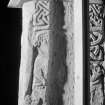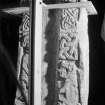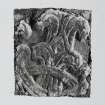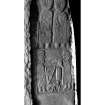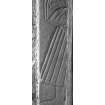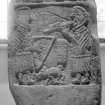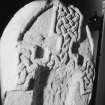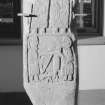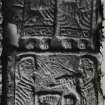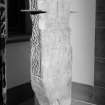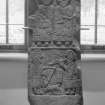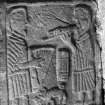Following the launch of trove.scot in February 2025 we are now planning the retiral of some of our webservices. Canmore will be switched off on 24th June 2025. Information about the closure can be found on the HES website: Retiral of HES web services | Historic Environment Scotland
Lethendy House
Cross Slab (Pictish), Pictish Symbol Stone (Pictish)
Site Name Lethendy House
Classification Cross Slab (Pictish), Pictish Symbol Stone (Pictish)
Alternative Name(s) Lethendy Tower; Tower Of Lethendy
Canmore ID 79896
Site Number NO14SW 13.01
NGR NO 1405 4170
Datum OSGB36 - NGR
Permalink http://canmore.org.uk/site/79896
- Council Perth And Kinross
- Parish Lethendy
- Former Region Tayside
- Former District Perth And Kinross
- Former County Perthshire
Lethendy, Tower of Lethendy, Perthshire, Pictish cross-slab
Measurements: H 1.35m, W 0.36m, D 0.13m
Stone type: sandstone
Place of discovery: NO 1405 4170
Present location: still at Tower of Lethendy but removed from the staircase and conserved in 2001. It is now freestanding and held upright on a base by metal clamps.
Evidence for discovery: first recorded by RCAHMS in 1969, when it was in use as a lintel on the stair in the late sixteenth-century tower house. It is thought to have been used for repairs in the seventeenth or eighteenth centuries, by which time it had already been in reuse for some other purpose, possibly more than once.
Present condition: there is considerable damage arising from the reuse of the stone. The lower arm and shaft of the cross are missing, removed when a shallow trough was carved into face A. A deep rectangular slot has been carved into the base of face C. The edges of the slab are damaged, and there are smooth patches from use as a whetstone for sharpening knives. There are also knife marks on face C.
Description
This is an interesting stone with detailed carving, though the standard of carving is not high. The slab has a naturally tapering base and a dressed rounded top, and it is carved in relief on both broad faces and the narrow faces, where traces of ornament continue over the rounded top. Within a flatband moulding, face A bears the upper part of a cross-head with rectangular terminals, square centre panel and double-square armpits. The background either side of the upper arm appears to be plain, but there was clearly ornament on either side of the missing shaft. This included a panel of diagonal key pattern at the top of the shaft, separated from the lower panels by a roll moulding. On the left the lower panel contains the remains of a human figure in profile facing the shaft, with curled hair. On the right there is first a double knot of cord with a median line, and below there is an animal placed upright facing the shaft, with a corrugated snout, fangs, a pricked ear and a short curled tail, wearing a collar.
Face C is almost intact and the layout of its design is clear. At the top is a frontal angel with half-open wings, apparently with a short feathered body and three-toed feet. Immediately beneath are two seated frontal figures, wearing elaborately draped robes to the ankle, where each has a decorative border of interlace, from beneath which protrude bare feet. The left-hand figure holds in the right hand a rectangular object, perhaps a book or a reliquary, while the right-hand figure appears to hold a chalice in the left hand and an oval object in the right. The right-hand end of the bench on which they are seated has a knobbed terminal (the left-hand end is damaged). Below these figures and separated from them by a roll moulding are two musicians shown in profile. They wear similarly draped and belted calf-length robes, and they have bearded faces with large oval eyes and prominent ears. The right-hand musician plays the triple pipes, while his partner plays a triangular harp. Between them in the background is a possible drum and in the foreground a small pig-like animal with curled tail.
Date: ninth or tenth century.
References: Fisher & Greenhill 1972; RCAHMS 1994, 97.
Compiled by A Ritchie 2016
Field Visit (19 April 1989)
NO14SW 13.01 1405 4170.
A fragment of this probable cross-slab has been re-used as a lintel above the staircase at the S end of the wing of the tower-house NO14SW 13.00; it was first noted in 1969.
Measuring at least 1.13m by 0.36m and 0.13m in thickness, it bears two panels of decoration, the upper showing an angel above two clerics, and the lower two musicians, a dog, and a rectangular object. The angel has outstretched feathered wings. The two clerics are dressed in vestments with decorated hems; one is carrying a book and the other appears to be holding a chalice. It is likely that the knotted pole to the right of the clerics is part of a throne, the left side of which is obscured. The two musicians of the lower panel face each other and wear tunics with waist bands; that on the left plays a harp and his partner a triple pipe. The rectangular object has been interpreted as a barrel-drum. The dog is a spirited representation with a curled tail and a collar. The decoration on the left-hand edge of the slab can just be detected by touch and appears to be a diagonal key-pattern.
The iconography and stylistic parallels of the stone place it in the tenth century.
Visited by RCAHMS (IMS) 19 April 1989.
I Fisher and F Greenhill 1974.



















